Guides
Herbaceous Vegetation Establishment Guide – North Dakota – View PDF
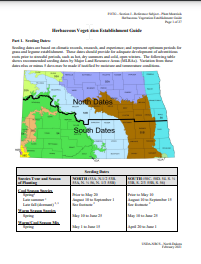
The North Dakota Field Technical Guide is the primary scientific reference for the NRCS. They contain technical information about the conservation of soil, water, air, and related plant and animal resources. Published by the NDSU Extension Service and USDA-NRCS. For all other states, please visit https://www.nrcs.usda.gov/resources/guides-and-instructions/field-office-technical-guides
Five Keys to Successful Grass Seeding – View PDF
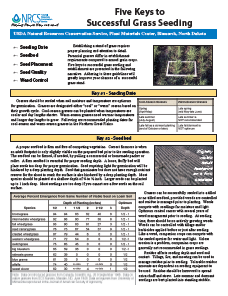
Establishing a stand of grass requires proper planning and attention to detail. Perennial grasses differ in establishment requirements compared to annual grain crops. Five keys to successful grass seeding and establishment are presented in the following narrative. Adhering to these guidelines will greatly improve your chances of a successful grass stand.
Reclaiming Disturbed Sites – View PDF
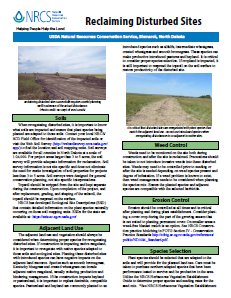
Reclaiming disturbed sites successfully requires careful planning well in advance of the actual disturbance.
Effects of Seeding Date on Warm-Season Grass Establishment – View PDF
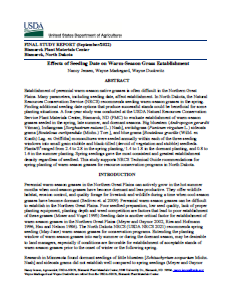
Establishment of perennial warm-season native grasses is often difficult in the Northern Great Plains. Many parameters, including seeding date, affect establishment. In North Dakota, the Natural Resources Conservation Service (NRCS) recommends seeding warm-season grasses in the spring. Finding additional seeding date options that produce successful stands could be beneficial for some planting situations.
Grasses
Grass Varieties for North Dakota – View PDF

This publication is designed to assist North Dakota producers and land managers in selecting perennial grass species and varieties for rangeland and pasture seeding and conservation planting. Each species is described following a list of recommended varieties (releases). Variety origin and the date released are included for additional reference. Published by the NDSU Extension Service and USDA-NRCS.
Grasses for the Northern Plains Cool Season – View PDF
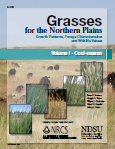
This publication is designed to summarize the growth patterns; forage characteristics, including nutritional value and herbage production; plant performance characteristics, including seedling and plant vigor, weed competition, stand density, stand rating, plant height, disease and seed production; salinity tolerance; fi ber content; wildlife values; and the list of varieties suited to the Northern Plains region for a select group of cool-season grasses. Published by the NDSU Extension Service and USDA-NRCS.
Grasses for the Northern Plains Warm Season – View PDF
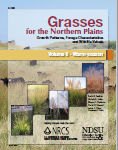
This publication is designed to summarize the growth patterns; forage characteristics, including nutritional value and herbage production; plant performance characteristics, including stand density index, stand rating and disease; fiber content; wildlife values; and a list of varieties suited to the Northern Plains ecoregion. This select group of warm-season grasses was studied at seven fi eld trial locations and two experiments in North and South Dakota and Minnesota. Published by the NDSU Extension Service and USDA-NRCS.
Establishing Grass Quick Guide – View PDF
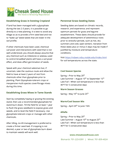
This quick guide covers seeding when glysophate has been used; using no till methods; and how to check the soil temperature to planting at the correct time.
Establishing grass do’s and don’ts – View PDF

This article was written by Pete Bauman from the SDSU Extension Office. Pete covers some of his experience with the South Dakota Grassland Management School. He highlights chemical uses on pasturelands, chemical history and new seedings, and the use of cover/forage mixes to reestablish grasses.
Establishing Native Grasses – View PDF

An NRCS instruction sheet on uses of Native grasses and their roles. This sheet covers how to prepare the site, with or without existing vegetation, planting dates, and use of herbicides.
Cover Crops
Cover crops as forage for grazing, know the risks and avoid them – View PDF
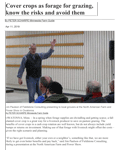
In a spring when forage supplies are dwindling and getting scarce, a fall planted cover crop is a great way for a livestock producer to save on pasture grazing. The benefits of cover crops in a cash crop rotation are well known, but do not always include yield bumps or returns on investment.
Cover Crop Common Species and Properties (Table) – View PDF

This table is a tool developed by the USDA and NRCS to select the proper cover crop for the properties desired. The document also lists salinity and frost tolerance. The information is compiled from several USDA-NRCS sources and from field observations across North Dakota.
2015 Cool and Warm Season Forage Field Trials NDSU Carrington – View PDF
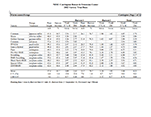
The NDSU Carrington Research Extension Center compared cool season and warm season forage in a field trial in 2015.
Study looks for most productive forage blends – View PDF
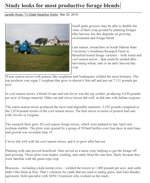
Researchers at South Dakota State University’s Southeast Research Farm in Beresford tested forage varieties – both warm and cool season mixes – that could be seeded after harvesting wheat, oats or an early harvest hay crop.
Alfalfa
Alfalfa Field Trial 20017 Minot – View PDF
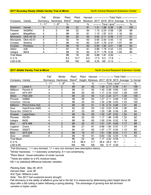
A 2017 Field Trial of Roundup Ready Alfalfa and Conventional Alfalfa in Minot by the North Central Research Center.
https://chesakseedhouse.com/wp-admin/edit.php?post_type=page
Yellow Alfalfa Field Trial – View PDF
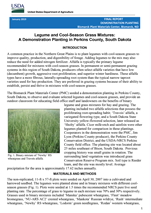
Legume and Cool Season Grass Mixtures comparison plots planted in Perkins County, South Dakota.
Pollinators
Pollinators Fact Sheet – USDA North Dakota – View PDF
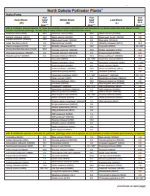
A list of the best pollinators for North Dakota, their bloom season, and seeding rates.
Salt Tolerant Species
Plant Materials for Salt-Affected Sites – View PDF
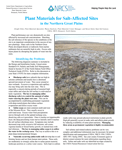
Plant performance can vary dramatically on sites affected by increased salt concentrations. Matching the salt tolerance of the species to the conditions at the site is an important consideration in the success of any new plantings.
Range Planning
Determining Carrying Capacity and Stocking Rates – View PDF
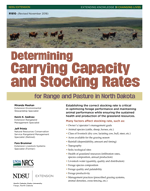
Establishing the correct stocking rate is critical in optimizing forage performance and maintaining animal performance while ensuring the sustained health and production of the grassland resources.